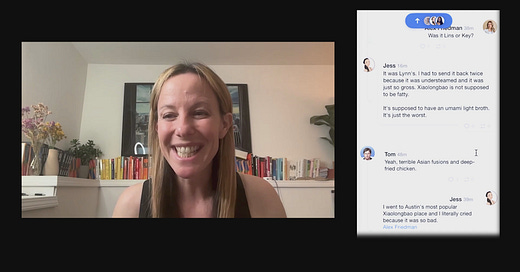TLDR: WATCH THE VIDEO (click above)
Strip away all the emojis, memes, and GIFs from your social media interactions. What's left? Your voice.
This is the gamble Airchat is making. It’s betting that in a world saturated with text and images, what we really crave is a return to the basics - talking. Is this a masterstroke in minimalism? Or a step back from what we've come to expect on other platforms?
How mental models work in social media
Want to understand how people interact with technology? You have to start with mental models. A mental model is a framework or set of beliefs and understandings about how something works.
This is the nut that Airchat has to crack to get adoption: how does it fit into the landscape dominated by existing platforms? Each of these has a distinctive mental model for what you share there:
✅ Instagram = photos and videos of daily life
✅ Twitter = provocative thoughts and ideas
✅ Clubhouse = live discussions based on interest
✅ TikTok = short videos set to music
✅ BeReal = pics of you doing you, in the moment
Airchat wants to introduce something new: asynchronous voice communication. This is a unique take. The obvious parallel is Clubhouse. Or Twitter. But while Clubhouse connects users around shared interests, Airchat puts the voice itself front and center. Gone is the visual and textual clutter of Instagram and Twitter. What’s left: someone talking at you. It kinda feels like the slow food movement for social media - slow social.
This gets at a core element of Airchat: its authenticity. Being able to share thoughts by voice makes interactions feel personal and direct. This lack of anonymity is likely to cause people to behave better. When we are more visible to others, we behave in ways that we think others will approve of.
Translation: It is more difficult for someone on Airchat to be a mean person (read: troll). In the video, I mention two studies that support that people behave a bit better when they are more visible:
In Ely, Iowa voters were randomly assigned to receive a mailing that indicated nonvoters’ names would be published in the local newspaper. People knew that if they didn’t vote, their names would be public. This worked to drive voting rates.
I also mention street lighting’s positive effect on crime in the video. Just kidding. After further investigation, I will retract that declaration. Lighting does work sometimes, but it’s not a big enough effect to claim.
Because of that retraction, I’ll throw you another study that supports the idea that being less anonymous gets people to behave better. This study was done by BIT on donations. The first group received only the messages from their colleagues. The second group received identical messages alongside a picture of the person. “Including the picture of the existing donor increased the number of people signing up from 2.9% to 6.4% - more than doubling sign-up rates.” This is not a ‘people like me’ result: they found that gender and location made no significant difference to people’s willingness to sign up.
Of course, there is a gotcha. High effort and visible engagement can be good for pro-social behavior on social media. But, it also likely means less people engage.
Why would less people engage? It is high effort and visible! People need to work for it. Recording my first Airchat took 10+ minutes and got me all worried. My post also didn’t produce any engagement. Sad face. Likewise, Airchat may end up looking a lot more like TikTok where a very small number of people post and most of us are just professional scrollers.
Key insights from the teardown:
🧠 The importance of mental models in shaping user experience
⚙️ Why design constraints can be powerful tools for behavior change
🎙️ What experiment NextDoor did to drive engagement with their feed
So, does Airchat open the door to a more “real” form of social media? Or set the stage for 1:Many interactions like TikTok? I’m only clear on one thing: this teardown could NOT have been a voice note. 🤔
💭 Thoughts on how voice could change social media? Share below (or send me a voice note)! See you next week for another deep dive. 👋
Have a friend who would enjoy these teardowns? Click the button below to refer them (& earn some great rewards)👇
Questions about your product? Email kristen@irrationallabs.com.
Want to increase conversion, retention, engagement? Reach out to Irrational Labs.
We design products that change behavior, using behavioral science. Check out our case studies to see it in action.




Share this post